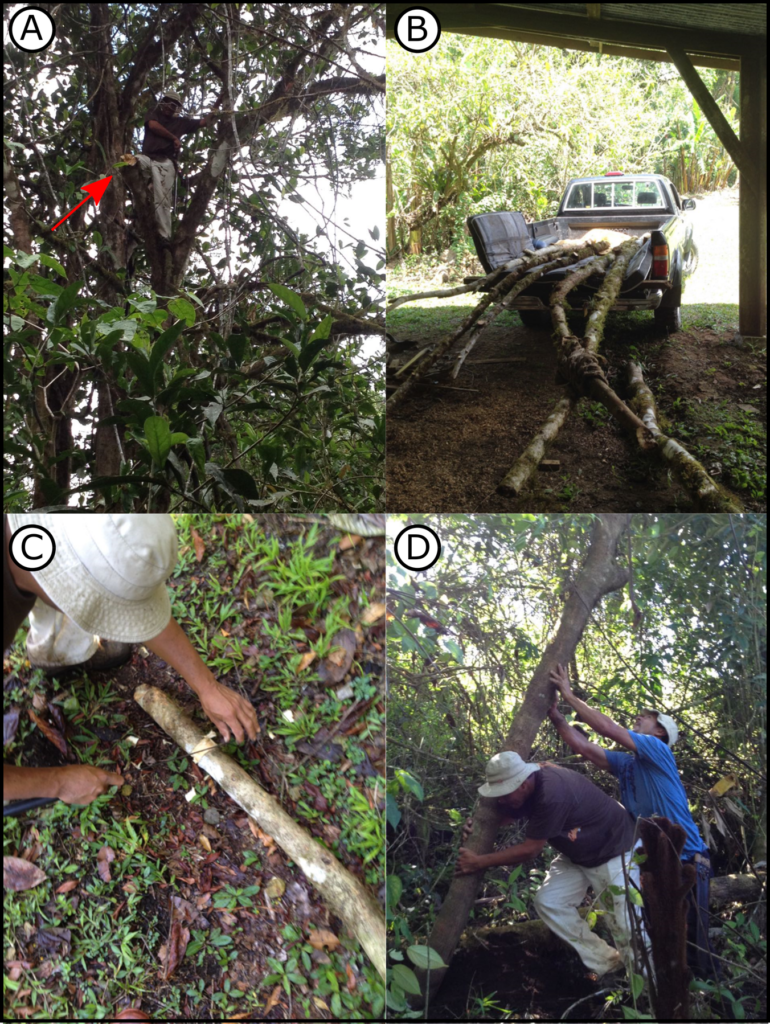By Leighton Reid and Rakan Zahawi
This blog is reposted with permission from the the Missouri Botanical Garden Natural History of Ecological Restoration blog
CCSD scientist Leighton Reid and Lyon Arboretum director Rakan Zahawi write about giant fig tree cuttings: how to make them and why some grow better than others.
Choosing the right species to include in a restoration project is a hard choice, but in the economy of nature, some species earn a bigger ROI than others. For example, Pacific sea otters maintain kelp forests by eating sea urchins, and wolves in Yellowstone National Park allow aspen groves to regenerate by scaring away tree-munching elk. These vital creatures are called “keystone species” because they hold ecosystems together, much like the keystone in an arch.

A keystone and three keystone species. (A) This small keystone holds up an arch in the Shoenberg Temperate House at Missouri Botanical Garden. (B) Sea otters are keystone predators in kelp forests. Photo by Marshal Hedin CC-BY 2.0. (C) Gray Wolves are keystone terrestrial predators. Photo by Gary Kramer USFWS CC-BY-NC 2.0. (D) A keystone fig tree feeding a Knobbed Hornbill in Sulawesi, Indonesia. Photo by T. R. Shankar Raman CC BY-SA 3.0.
Plants can be keystone species too. Around the world there are about 800 species of fig trees, and they hold tropical forests together by providing food for a wide array of animals. On any given day, the busiest tree in a rain forest is likely to be a fig tree with fruits. Monkeys, birds, bats, and others gather at fig trees to eat, and in the process, they deposit seeds of other plant species that they have been carrying in their guts. This chain of events, repeated day after day, often turns the area beneath a fig tree into a hotspot of plant diversity.
A few years ago, we had an idea to plant keystone fig trees in young forests in Costa Rica. We wanted the figs to grow as fast as they could, so instead of planting seedlings, we planted cuttings – big ones. With help from our local collaborator, Juan Abel Rosales, we cut dozens of twelve foot-long branches from eight species of fig trees. We stripped off all of their leaves to keep them from drying out, and then we planted our figs trees in shallow holes.
To our delight, many of the fig trees grew!
The ones that did the best came from a special group, the subgenus Urostigma. Many figs in this group have a unique life strategy. They begin their lives in the top of a tree when their tiny seeds are deposited on a branch by a bird or some other animal. As they grow in the treetop, they send long roots down to the ground, and these roots harden and fuse together, forming a lattice-like trunk. Over time, these figs kill their host trees by taking most of the water, nutrients, and light. They also keep the host tree from growing outwards, giving them the nickname “strangler figs”. Maybe the ability to transform a flimsy, dangling root into a solid trunk is related to these figs being able to grow from cuttings.
To find out how well our planted fig cuttings might survive over the long-term, we also tracked down some fig cuttings that we had planted in 2004. We were happy to learn that out of the trees that survived for their first three years of life, all of them were still thriving a decade later.
Full disclosure: planting large cuttings is not a new idea. Farmers in many parts of the tropics plant trees this way to create ‘living fences’ – with all of the normal fixings like gates and barbed wire, but with a row of living trees instead of dead posts. The advantages for farmers are many – their fences don’t rot and fall apart (that happens quickly in the tropics); the trees provide shade for cattle; they have a constant source of new fence posts (by cutting off a limb); and in some cases they can feed the young shoots to livestock.
Big cuttings have big benefits for restoration too. Not only are planted trees already several feet tall, you also get to skip the pricey nursery phase, and, most excitingly, cuttings have a tendency to fruit quickly.
Some of our young fig trees are now making fruit, but we will have to wait a bit longer to see whether they start attracting more big animals and whether those animals carry more tree seeds into our young forests. For now, we can say that others who are interested in growing keystone figs for forest restoration may have the best luck by working with the stranglers.
For more information, please take a look at our open access paper on this project in Perspectives in Ecology and Conservation and prior blog posts here, here, and here.

How to grow an instant fig tree. (A) Remove a long, thin branch segment from an adult tree. The red arrow shows a cut branch. (B) Strip the cuttings of their leaves to keep them from drying out, then carefully transport cuttings so as not to damage cortical tissue. Here, cuttings are padded by a foam mattress. (C) Remove the bark from a ring on the cutting to promote root growth. Here, a ring is being cut about 20 cm (8 in) above the base so that it will be just below the soil surface when planted. (D) Dig a shallow hole and plant the cutting. Be sure that the cutting is firmly planted to prevent it from toppling, but take care not to compact the soil too much around its roots. Photos by Rakan Zahawi.
Study location: Puntarenas Province, San Vito, Costa Rica


